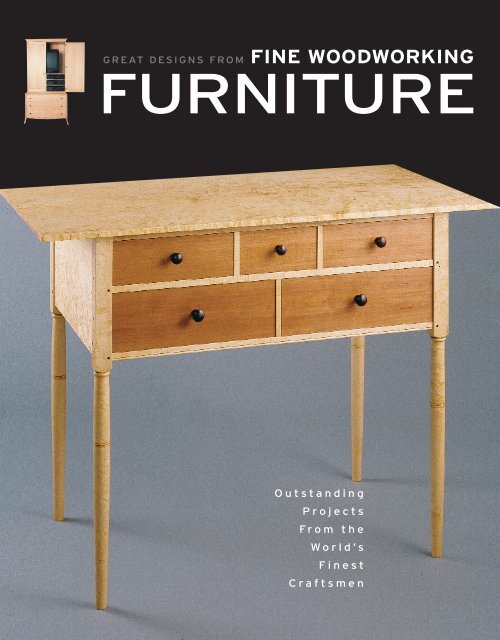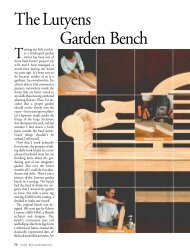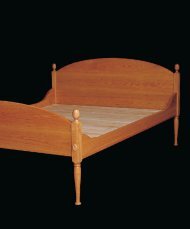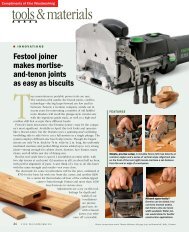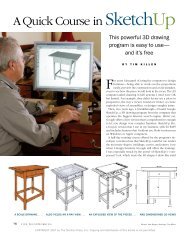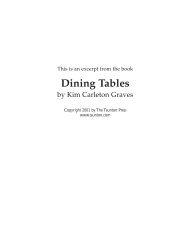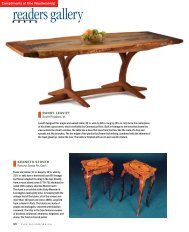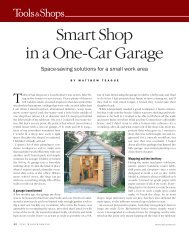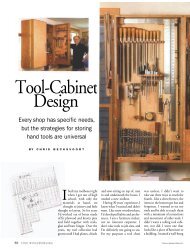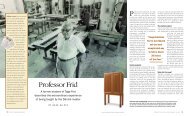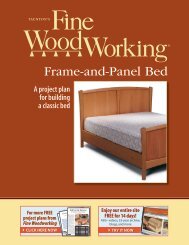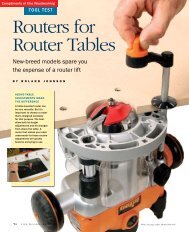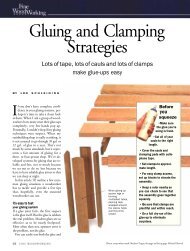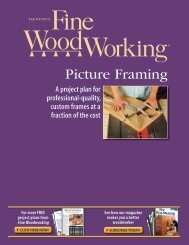An ExpAndAblE TAblE - Fine Woodworking
An ExpAndAblE TAblE - Fine Woodworking
An ExpAndAblE TAblE - Fine Woodworking
You also want an ePaper? Increase the reach of your titles
YUMPU automatically turns print PDFs into web optimized ePapers that Google loves.
G R E AT D E S I G N S F R O M FINE WOODWORKING<br />
FURNITURE<br />
O u t s t a n d i n g<br />
P r o j e c t s<br />
Fr o m t h e<br />
W o r l d ’ s<br />
F i n e s t<br />
C r a f t s m e n
98<br />
G R E AT D E S I G N S F R O M F I N E W O O D W O R K I N G<br />
<strong>An</strong> Exp<strong>An</strong>dAblE <strong>TAblE</strong><br />
b y W i l l i a m K r a s e<br />
Hidden hinges.<br />
The Soss®-brand<br />
invisible hinges face<br />
the wall when the<br />
tabletop is flded and<br />
are concealed with<br />
the top open.
A SImple WAy to exp<strong>An</strong>d A tAble<br />
To convert the table from its compact mode, the top is turned 90° on the pivot<br />
carrier (see detail below); then the top is opened to full size.<br />
Each section of top, 3/4 in.<br />
thick by 36 in. wide by<br />
25 in. long<br />
Blocking, 1/2 in. thick by<br />
5 in. square, is glued and<br />
screwed to the underside<br />
of the tabletop.<br />
Pivot carrier, 3/4 in.<br />
thick by 5 in. wide<br />
Brass strip,<br />
1/16 in. thick<br />
End aprons, 22 in. long,<br />
are 4 1/2 in. wide at the<br />
center and 5 in. wide at<br />
the ends.<br />
vividly remember the colorful language my mother<br />
I used when I was a kid as she struggled to extend a<br />
removable-leaf table that was prone to jamming. So<br />
when a client asked for an expandable table, I sought a<br />
better solution. My client wanted a table that would fit<br />
against a wall and seat two and that on occasion could<br />
expand to seat six. He expected some sort of drop-leaf<br />
table, but it’s difficult to sit around that kind of table<br />
when the leaves are down.<br />
I recalled seeing a table where the top pivoted and<br />
then unfolded to double in size, a solution I thought<br />
would meet the needs of my client. The design meets<br />
several challenges inherent in this type of table. The<br />
central problem is that a fixed base must accommodate,<br />
with adequate stability, both a small top and one that<br />
is twice the size. At the same time, the footprint of the<br />
base should not extend beyond the “shadow” of the<br />
hinged top in its contracted size, lest the legs of the<br />
table conflict with the feet of the user.<br />
Pivot registration piece, 3/4 in. thick<br />
by 1 1/2 in. wide by 4 in. long, is screwed<br />
to the underside of the tabletop.<br />
Pivot-carrier<br />
cleats, 3/4 in.<br />
thick by 2 in.<br />
wide by 8 in.<br />
long<br />
Front and back aprons,<br />
32 in. long, are 4 in. wide<br />
at the center and 5 in.<br />
wide at the ends.<br />
Pivot stops, 3/4 in. thick by 1 1/2 in.<br />
wide by 2 in. long, are screwed to<br />
the front and back aprons.<br />
Legs, 30 in. long, taper on<br />
all sides from 1 3/4 in. square<br />
at the top to 3/4 in. square<br />
at the bottom.<br />
No pivoting beyond this point. The pivot stops fit snug<br />
inside the recesses of the T-shaped registration piece.<br />
pIvot-mech<strong>An</strong>ISm detAIl<br />
The tabletop rotates on a single point using a<br />
machine bolt screwed into a threaded insert.<br />
Tabletop<br />
3/8-in., 24-tpi<br />
threaded brass<br />
insert and bolt<br />
Cleat<br />
Pivot carrier<br />
Blocking<br />
Brass strip, drilled<br />
and filed to fit<br />
around bolt head<br />
The use of SOSS hinges (www.soss.com) permits<br />
the leaf to fold over 180 degrees in the closed position.<br />
When the table is open, though, the hinges are concealed.<br />
Two would have given enough strength, but<br />
I elected to use four hinges to help keep the leaves<br />
aligned.<br />
The folding method I used is suitable for larger<br />
tables with a length-to-width ratio of 1.2 to 1.8, but<br />
it is not suitable for square, round, or oval tabletops.<br />
I made the open table boat-shaped, a design that<br />
affords everyone a better view of each other and that<br />
is conducive to conversation. The edge profile must<br />
take into account the sometimes-inverted position of<br />
one leaf. I used a simple long-radius roundover bit<br />
guided by a template.<br />
I chose to splay the legs for extra stability and to<br />
taper them all the way to the bottom. The ends of<br />
the aprons are all 5 degrees from the vertical with<br />
the tenons cut on the tablesaw. Strictly speaking, the<br />
A N E X P A N D A B L E TA B L E 99
The best way to locate the pivot<br />
point is to make an accurate<br />
scale drawing of the table frame.<br />
Overlay this with a plan of the<br />
tabletop in its folded position so<br />
that you can see the relationship<br />
between the frame and the top,<br />
both in its normal position and<br />
rotated 90 degrees. Point A is the<br />
midpoint of the hinge line with the<br />
table folded in the two-seat position,<br />
while point B is the midpoint<br />
of the hinge line with the tabletop<br />
rotated and in the six-seat position.<br />
Draw lines from both points at<br />
45 degrees to the line A-B; their<br />
intersection marks the pivot point<br />
(C). Now, the pivot carrier and the<br />
pivot stops can be drawn in.<br />
Measurements from the scale<br />
drawing can be taken to locate the<br />
pivot point on both the pivot carrier<br />
and the tabletop.<br />
The pivot is a 3 ⁄8-in., 24-tpi<br />
machine bolt that mates with and<br />
turns in a threaded brass insert in<br />
the tabletop. The insert is set in a<br />
tenons should have been cut at a compound angle due<br />
to the splay of the legs, but I didn’t do this because<br />
the second angle for a 5 degrees splay is a negligible<br />
0.2 degrees. Make a scale drawing to locate the<br />
position of the pivot point (above).<br />
Next, the recesses for the hinges need to be cut.<br />
Because the deep recesses are awkward to cut on<br />
the edge of the large tabletop, I made a 12-in.-tall<br />
auxiliary fence for my router table.<br />
After the aprons and legs had been assembled, I<br />
attached the pivot carrier, which provides a point<br />
on which the tabletop can turn. The pivot carrier is<br />
secured to two blocks that are screwed to the aprons.<br />
100 A N E X P A N D A B L E TA B L E<br />
Locating and Mounting the Pivot<br />
block that’s glued and screwed to<br />
the underside of the tabletop. The<br />
insert requires a nominal 1 ⁄2-in.<br />
pilot hole and is 5 ⁄8 in. long.<br />
Screwing the insert into hardwood<br />
is much easier if the nominal<br />
pilot hole is enlarged by 1 ⁄32 in. To<br />
install the insert perpendicular to<br />
the surface, use an auxiliary block<br />
of wood to make things easier.<br />
The machine bolt passes<br />
through the pivot carrier and into<br />
the threaded insert. This type of<br />
FIndIng the pIvot poInt<br />
First locate the center of the hinge line in the two-seat (A) and six-seat (B) positions. Then<br />
project lines from these points at 45°. The intersection of these lines (C) is the location of<br />
the pivot point.<br />
Pivot<br />
point<br />
Pivot<br />
carrier<br />
Table rotated but not unfolded<br />
c<br />
•<br />
A<br />
•<br />
45°<br />
45°<br />
•<br />
b<br />
Hinge<br />
line<br />
Midpoint of the hinge<br />
line with the table in the<br />
two-seat position<br />
Table<br />
folded<br />
in the<br />
two-seat<br />
position<br />
Midpoint of the hinge<br />
line with the table in<br />
the six-seat position<br />
pivot should be arranged to tighten<br />
a quarter turn when the table is<br />
expanded. This will pull the parts<br />
together very slightly, so clearance<br />
over the pivot carrier should be<br />
allowed.<br />
The final step is to add a brass<br />
strip to prevent the pivot bolt from<br />
loosening or falling out. The strip is<br />
drilled and filed to fit over the bolt<br />
head and is screwed to the pivot<br />
carrier at the other end.<br />
The carrier is angled to expose the two stops that<br />
also are screwed to the aprons and limit the swivel<br />
motion. These stops register against a T-shaped piece<br />
of wood screwed to the underside of the leaf that<br />
doesn’t flip over.<br />
All tables of this design have one drawback: They<br />
cannot be lifted when the tabletop is open because<br />
the only permanent connection with the base is the<br />
pivot mechanism.<br />
William Krase is a retired aerospace engineer who lives in<br />
Mendocino, California.


